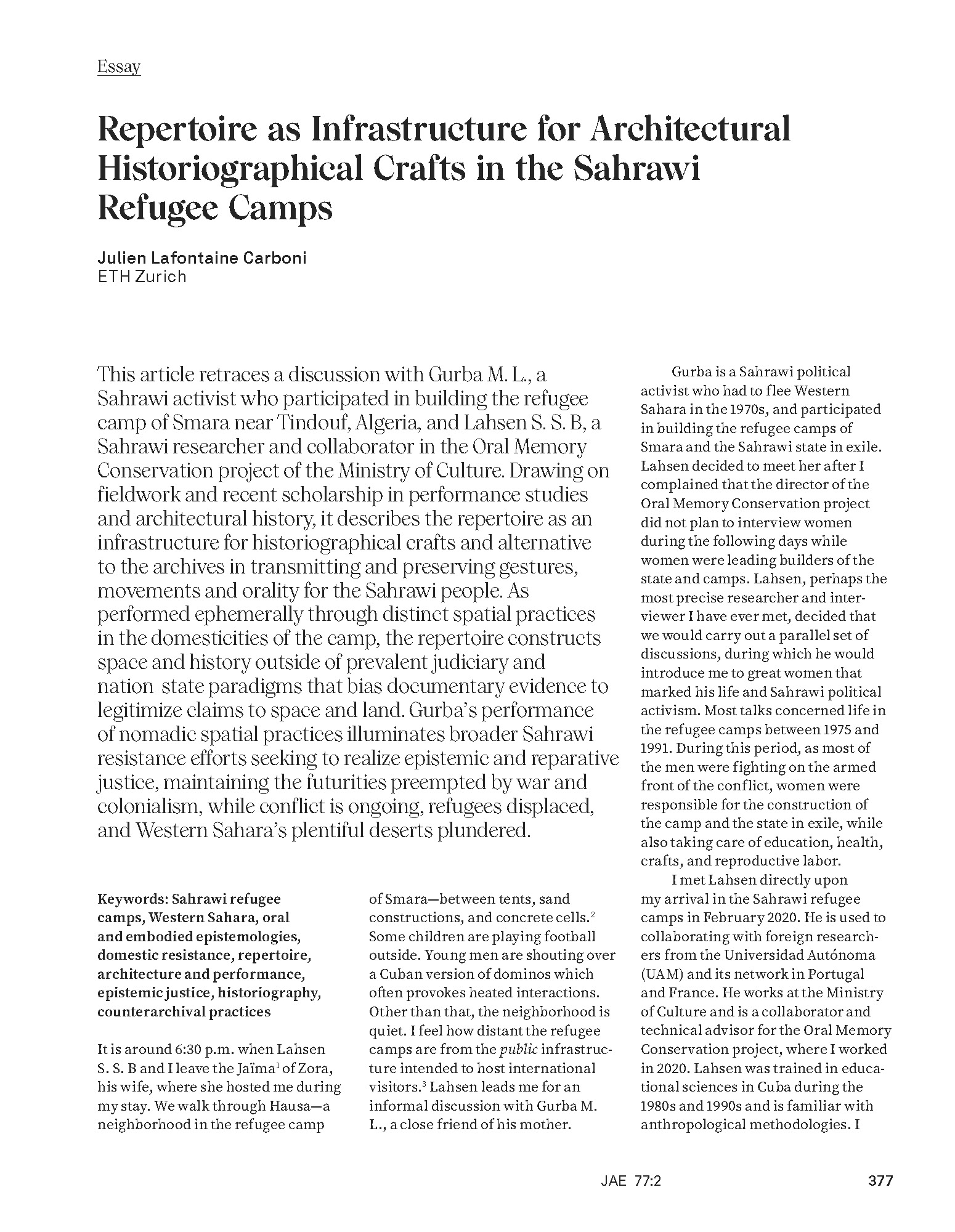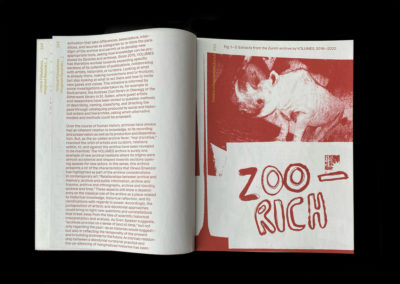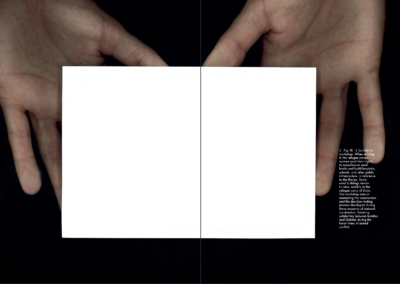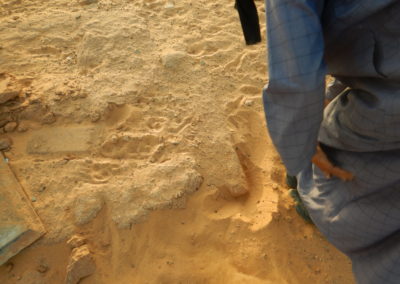article
Repertoire_info
Repertoire_image

Repertoire_text
This article retraces a discussion with Gurba M. L., a Sahrawi activist who participated in building the refugee camp of Smara near Tindouf, Algeria, and Lahsen S. S. B, a Sahrawi researcher and collaborator in the Oral Memory Conservation project of the Ministry of Culture. Drawing on fieldwork and recent scholarship in performance studies and architectural history, it describes the repertoire as an infrastructure for historiographical crafts and alternative to the archives in transmitting and preserving gestures, movements and orality for the Sahrawi people. As performed ephemerally through distinct spatial practices in the domesticities of the camp, the repertoire constructs space and history outside of prevalent judiciary and nation-state paradigms that bias documentary evidence to legitimize claims to space and land. Gurba’s performance of nomadic spatial practices illuminates broader Sahrawi resistance efforts seeking to realize epistemic and reparative justice, maintaining the futurities preempted by war and colonialism, while conflict is ongoing, refugees displaced, and Western Sahara’s plentiful deserts plundered.
article
Chèrex créaturex_info
Chèrex créaturex_image

Chèrex créaturex_text
This letter, addressed to a creature taking the form of a human chimera gathering the thoughts and knowledge of people who inspire and accompany us, recounts the experiences, affects and issues related to our first semester of teaching the course named DRAG(U.E.): performativity of the built environment. Questioning the norms of domination of our living and learning spaces through feminist, queer, and de/post-colonial perspectives within an institution where they are absent, raises doubts, risks, and often anger. This letter therefore also questions the fragility and limits of our resistant practices in academic spaces, while making visible their necessities and strengths, as well as the solidarities that are created and spread.
book
Unearthing Traces_info
Unearthing Traces. Dismantling the imperialist entanglements of archives, landscapes and the built environment, Nitin Bathla, Denise Bertschi and Julien Lafontaine Carboni (editors), EPFL Press, 2023.
Unearthing Traces_text
Dismantling imperialist entanglements of archives, landscapes and the built environment“
Designed by Melina Wilson & Martin. Stoecklin (@_a_language_ @wilson_melina @marstoeck).
„Archival power, silences, and absences profoundly shape and structure postcolonial landscapes, spaces, and urban environments by controlling bodies, histories, and interactions. This book explores pathways to dismantle these imperial entanglements by developing methodologies and plural epistemologies through an interdisciplinary dialogue between the fields of history, memory politics, critical theory, and archival practice together with the fields of the built environment, landscape, urban studies, architecture, and the arts. Unearthing traces catalyzes critical discussions that not only challenge the objectivity and dismantle the neutrality surrounding current archival practices and archival institutions, but also questions what constitutes as the archive itself. The book unearths potential histories and minor narratives buried by the imperial production of pasts and silences. The diverse range of contributions in the book offer original research, discussions, positions, and tools and provides a critical resource for scholars, architects, artists, activists, and archivists who want to engage with landscapes and built environments in a critical and postcolonial perspective in relation to archival materials and practices.“
Contributors:
Denise Bertschi
Nolan Oswald Dennis @data_body
Abdessamad El Montassir and Julien Lafontaine Carboni @abdessamadelmontassir @jllfcb
Rohit Jain
Hollyamber Kennedy
Léopold Lambert @leopold_lambert_
Françoise Vergès @francoise_verges_decoloniale
Anna Karla de Almeida Santos @annakarlaalmeida
Lena Stina Andersson
Mari Bastashevski @maribastashevski
Jasmine Benhaida
Mathilde Chénin
VOLUMES and Decolonize Zurich @volumeszurich@decolonizezurich
Fares Damien @faresdamien
Atiya Hussain and Stéphanie Savio @stephanie_savio_
George Jepson and Lukas Pauer @nosoeg @thevglthinktank
Sila Karatas @rus.in.urbe
Nagy Makhlouf @power.and.space
Estefanía Mompean Botias @estefaniamompean
Rebecca J. Squires @squiresgrandtour
Safiya El Ghmari and Tafrata Bouchra @sinbad.epub
Lea Marie Nienhoff
Alina Volynskaya
Marlene Wagner @mw_marlenewagner
Publishers and supports of the publication:
@epflpress @cancentredartneuchatel, @epflarchitecture, the Institute and the Section of Architecture, EDAR, SwissUniversities.
thesis
(from) the repertoire_info
(from) the repertoire: an architectural theory of operations. Oral and embodied knowledge in architectural and spatial practices. Thesis, EPFL, 2022.
(from) the repertoire_text
This research delves into oral and embodied architectural and spatial knowledge as modes of producing buildings, spaces and spatialities. This knowledge is transmitted body-to-body through the temporalities of performance, its acts of remaining and means of reappearance, and relies on the repertoire as an infrastructure of transmission and conservation, an organic counterpart to the archives.
(from) the repertoire introduces an architectural theory of operations, opening up the potentialities of oral and embodied modes of architectural production. Epistemological thresholds enable to make contact with the repertoire’s forms of imagination and invention, transmission and migration, historical regimes and potential histories, remainders and agencies. Architectural historiography and image are renegotiated in order to consider the ontology of operations, gestures and words.
The core of this thesis revolves around discussions with older generations of the Sahrawi people, in the refugee camps near Tindouf, South Algeria, within an oral memory preservation program. This manuscript explores how their architectural histories, knowledge and theories, while entirely undrawn and unwritten, are crafted, preserved and transmitted. A discussion with Gorba M.L., a Sahrawi woman who participated in the construction of the camps and the Sahrawi State in exile, unfolds the architectural agency of gestures on plural temporalities and materialities. By sharing her repertoire, she introduces a spatial practice of repair, giving agency to preempted futurities as present corporeality.
The immobilization of the Sahrawi people, a product of colonial violence, short-circuits the repertoire. In this context, the ethics and paradoxes of preserving and archiving the repertoire are examined, and, at the same time, strategic relationships are proposed that escape the toxicity of historical discourses by supporting the re-enactment of knowledge. Furthermore, this research investigates practices that momentarily stabilize the ontology of operations and enable the repertoire to circulate. Coined as architectural reenactments, and together with a theory of operations, these practices open a field, a zone of peaceful reconciliation with knowledge from the repertoire, granting access to its scales and temporalities from within the discipline and in view of integrating it in curricula and research.
bookchapter
Magnitudes_info
“Magnitudes of Sahrawi Nomadism throughout Colonialism and Refugeehood.” Lafontaine Carboni, Julien, and Juan Carlos Gimeno Martín, In State, Society and Islam in the Western Regions of the Sahara: Regional Interactions and Social Change, edited by Francisco Freire, 69–86. I.B. Tauris, 2022.
https://doi.org/10.5040/9780755643493
Magnitudes_text
The nomadic/sedentary binary has been criticized as a Western construction. Its deconstruction is particularly necessary in contexts where nomadic populations become refugees for climatic, political, and/or economic reasons. This has been the case for the Sahrawi exiles in Algeria since the territorial invasion and occupation, which began in 1975. On several occasions, the Sahrawi refugee camps near Tindouf have been analyzed in relation to prior nomadic encampments. By analyzing both the quotidian and the more exceptional movements of the Sahrawi throughout the twentieth century and their forms of settlement in the refugee camps, we will consider the various magnitudes of nomadism at play in this context. There is an urgent need to consider several temporal and geographic scales in this analysis of nomadism—from temporal duration to population movements—and to understand the sedentarization process of the camps as a temporary survival.
The nomadic/sedentary binary has been criticized as a Western construction. Its deconstruction is particularly necessary in contexts where nomadic populations become refugees for climatic, political, and/or economic reasons. This has been the case for the Sahrawi exiles in Algeria since the territorial invasion and occupation, which began in 1975. On several occasions, the Sahrawi refugee camps near Tindouf have been analyzed in relation to prior nomadic encampments. By analyzing both the quotidian and the more exceptional movements of the Sahrawi throughout the twentieth century and their forms of settlement in the refugee camps, we will consider the various magnitudes of nomadism at play in this context. There is an urgent need to consider several temporal and geographic scales in this analysis of nomadism—from temporal duration to population movements—and to understand the sedentarization process of the camps as a temporary survival.
article
Undrawn_info
“Undrawn Spatialities. The Architectural Archives in the Light of the History of the Sahrawi Refugee Camps.” Architecture and Culture 9, no. 3 (April 29, 2021): 502–22.
https://doi.org/10.1080/20507828.2021.1894063
Undrawn_text
What happens if architectural knowledge is not mediated through drawing or does not produce any type of record? How can an architectural archive exist and make sense in a context where the circulation of knowledge and the emergence of spatialities leave no physical traces? This essay offers insights into the traces left by undrawn spatialities and how they could be recorded and interpreted in architectural archives based on observations on the history of the Sahrawi refugee camps in archiving oral memories in collaboration with the Sahrawi Ministry of Culture. A project was launched to archive and maintain nomadic knowledge circulation that has been short-circuited by protracted immobilization. This essay proposes that gestures, words and bodies- as producers of undrawn architecture -allow other regimes and traces of spatialities to emerge.
article
Inconnues_info
“Les Inconnues Éblouies.” Julien Lafontaine Carboni and Paule Perron. Plan Libre, Summer 2021.
Inconnues_article
article
Inmóviles_info
“Inmóviles, Pero No Quietos. La Sedentarización de Los Saharauis Como Estrategia de Adaptación y Respuesta a La Supervivencia. Sobre La Posibilidad de Un Nomadismo Inmóvil.” Julien Lafontaine Carboni and Juan Carlos Gimeno Martín. Tabula Rasa, 2021.
Inmóviles_text
La dicotomía nómada/sedentario es cuestionada aquí como una construcción occidental. Su deconstrucción es necesaria cuando las poblaciones nómadas se convierten en refugiadas por razones climáticas, políticas o económicas. Es el caso del exilio saharaui en Argelia tras la invasión de Marruecos de su territorio en 1975, y la ocupación del Sáhara Occidental hasta hoy. Los campamentos de refugiados saharauis cerca de Tinduf, Argelia, son considerados aquí en relación con la forma de vida nómada pastoril anterior al conflicto. Analizando la vida cotidiana en los movimientos más excepcionales de los saharauis durante el siglo XX y sus formas de asentamiento, queremos contribuir a este debate, en relación con los campamentos de Tinduf, formulando una hipótesis sobre la existencia de un nomadismo inmóvil saharaui. Defendemos la necesidad de considerar una diversidad de escalas de tiempo en el análisis del nomadismo, desde la consideración del momento, hasta la larga duración de los movimientos de la población, entendiendo el proceso de sedentarización de los campamentos saharauis como una estrategia temporal de supervivencia.
bookchapter
article
article
bookchapter
article
bookchapter
















